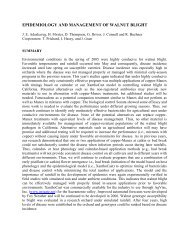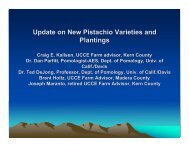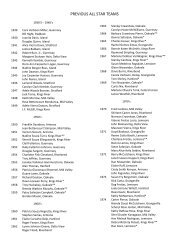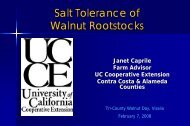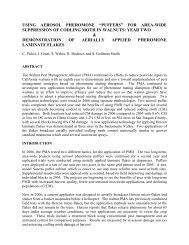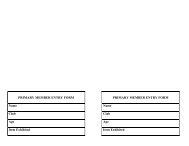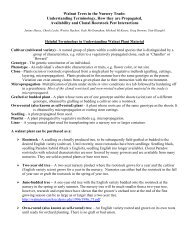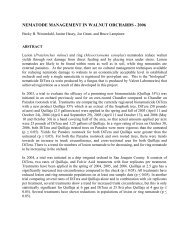Walnut Rootstock Clones - Kings County
Walnut Rootstock Clones - Kings County
Walnut Rootstock Clones - Kings County
You also want an ePaper? Increase the reach of your titles
YUMPU automatically turns print PDFs into web optimized ePapers that Google loves.
January 2008 Volume 14 / NO. 1<br />
Pa c i f i c Nu t Pr o d u c e r / January 2008<br />
<strong>Walnut</strong> Clone Plantings<br />
The Next Frontier<br />
1
In early January, Bob Beede, UC Cooperative Extension farm<br />
advisor, <strong>Kings</strong> <strong>County</strong>, left, with Jeb Headrick look over a cloned<br />
Vlach rootstock planted in August 2007.<br />
<strong>Walnut</strong> Clone Plantings<br />
Containerized Stocks Need Careful Consideration<br />
By Patrick Cavanaugh, Editor<br />
When Don and Jeb Headrick took<br />
delivery of their containerized paradox<br />
Vlach cloned rootstocks in August 2007,<br />
they were excited about the prospects<br />
of planting 35 acres of the vigorous,<br />
genetically strong tree.<br />
Planting in August, you may ask<br />
Yes, with firmly rooted in-the-pot plants,<br />
it’s theoretically possible to plant at any<br />
time. What about triple digit temperatures<br />
a week or so following planting<br />
What about the initial shock that is anticipated<br />
with any transplant operation<br />
And, what about early winter frost on<br />
the sensitive trees<br />
The Hanford, Calif. father and son<br />
team, veteran walnut growers with 300<br />
mature acres and 110 acres in development,<br />
suddenly found themselves<br />
getting a new education in walnut<br />
growing.<br />
The supplier of the potted, four-inch<br />
tall clonal rootstock was Duarte Nursery<br />
who is on schedule to deliver an additional<br />
shipment to the Headricks in April<br />
for another 35-acre planting. “They said<br />
it was important to keep the root ball of<br />
the small trees moist,” said Jeb. “So we<br />
put in a very cost-effective drip irrigation<br />
system with a one gallon emitter at each<br />
tree. A week later, there was five days<br />
of 105-108 temperatures.<br />
“At planting, the trees went into<br />
shock, and then we got hit by the hot<br />
weather,” noted Jeb. “I was surprised<br />
at the extent of the shock and I didn’t<br />
know what to expect.” He said the hot<br />
temperatures shut down photosynthesis<br />
and the trees started going into survival<br />
mode, using stored energy reserves.<br />
“I was nervous,” Jeb said. “We kept<br />
walking around the field with moisture<br />
meters and probing. When the hot<br />
weather hit we found that a quick shot of<br />
water worked best. After the hot weather<br />
the terminal bud hardened off due to<br />
shock, hot weather, and possibly over<br />
watering initially. It arrested continued<br />
growth, but the leaves looked good going<br />
into the warm fall.”<br />
In mid-October, Jeb, along with<br />
Bob Beede, UC Cooperative Extension<br />
farm advisor, <strong>Kings</strong> <strong>County</strong>, dug up<br />
a root ball for observation and found<br />
the roots healthy and growing. “It was<br />
encouraging,” he said, adding that<br />
Beede has been coaching him in all<br />
manners of how to treat the tiny trees<br />
in the field. With all the challenges of<br />
the current planting the Headricks loss<br />
less than one percent of the plants—a<br />
possible testament of the strength of the<br />
(continued on page 22)<br />
4 Pa c i f i c Nu t Pr o d u c e r / January 2008
<strong>Walnut</strong> <strong>Clones</strong><br />
(continued from page 4)<br />
vigorous Vlach clone. One percent loss<br />
is the same as that experienced in their<br />
older bare root plantings.<br />
When they planted the trees, the soil<br />
was moist from pre-plant irrigation. “In<br />
talking with Duarte, they said the postplant<br />
priority was to keep the root ball<br />
moist and to make sure the drip emitter<br />
was right next to each tree,” said Jeb.<br />
“We made sure we did that and anchored<br />
the tubing with wire hoops at each tree<br />
to keep it from shifting.”<br />
To save on the huge capital cost of<br />
a conventional drip filtration system,<br />
Don Headricks devised a simple, but<br />
ingenious system using a 4 hp Honda<br />
two-inch water pump at the edge of the<br />
field. It draws water from a PVC pipe<br />
epoxied into a hole created in a 12-inch<br />
valve lid on their existing conventional<br />
pipe line. The pressurized water then<br />
passes through a 100 mesh in-line<br />
screen filter. This is then connected to<br />
a lateral line in the middle of the field,<br />
which distributes it to the drip tubes.<br />
The use of quick-connect flexible hoses<br />
allows removal of the pump when not<br />
Jeb Headrick, left and his father Don are optimistic that the tough start on their<br />
most recent planting will catch up this spring.<br />
in use to avoid theft. “The amazing<br />
thing about this is that we run the motor<br />
just over an idle and it does the whole<br />
field at one gallon an hour per emitter,”<br />
noted Jeb.<br />
“Not knowing for sure, we ended<br />
up applying more water than was probably<br />
needed at first. But then we backed<br />
off and applied about a quart every 3-5<br />
days, which meant the pump was run-<br />
Could the Solution to the Planting Dilemma<br />
be Custom Growing<br />
Bob Beede, UC Cooperative Extension farm advisor, <strong>Kings</strong> <strong>County</strong>, thinks<br />
that some growers might be better served if the potted clones were custom grown<br />
by the grower’s selected nursery and then delivered during the traditional winter<br />
planting season as bare root June-budded trees.<br />
Presently, growers plant a two year-old nursery tree, with the second year<br />
serving as the development period for the English scion whipped grafted during<br />
the winter. This is in contrast to a June-budded walnut tree, which is planted in<br />
the nursery in the early spring, budded in June, and then dug as a one-year-old<br />
tree the following winter.<br />
“The proposal for custom growing would insure walnut growers of having<br />
successfully budded rootstock with good root structure for development of the<br />
main trunk during its first year in the orchard,” said Beede.<br />
“This custom growing concept differs from planting clonal materials in the<br />
field, in that growers will be faced with the challenge of having to successfully<br />
bud the rootstock in their fields and then achieve a growth rate of the English<br />
scion equal to an inch a day in order to have a tree at least eight feet tall for<br />
dormant heading,” Beede said. “Failure to achieve this first season goal, will<br />
require that the scions be headed back and re-grown during the second season-<br />
--losing a year in orchard development.”<br />
This distinct possibility requires individual farmers to assess their horticultural<br />
skills in walnut plant development. Inexperienced growers may not want<br />
wish to assume this risk, noted Beede.<br />
Tom Burchell sounded off on Beede’s concept. “To me it sounds like what<br />
we have been doing all along,” Burchell said. “We get the order and grow the<br />
trees out. We like the custom growing concept because we are field grown<br />
operation.”<br />
22 Pa c i f i c Nu t Pr o d u c e r / January 2008
ning only 12 minutes,” said Jeb. “We<br />
found that this was enough to keep the<br />
root ball moist.<br />
Despite the early worries, Jeb thinks<br />
the trees will really take off next month<br />
in February. “With good root growth,<br />
with good shots of water and fertilizer,<br />
they should take off this spring. Then we<br />
will bud them to Chandler in late May.<br />
If not, we may let them grow another<br />
year before budding,” said Jeb.<br />
Off Tradition<br />
Like most walnut growers, the<br />
Headricks traditionally have planted a<br />
bare-rooted, grafted walnut tree grown<br />
in a commercial nursery for two years.<br />
These standard trees require the first year<br />
to grow the rootstock from seed. At the<br />
start of the second year, the desired English<br />
walnut scion is whip-grafted onto<br />
the rootstock and grown for yet another<br />
year before digging and delivery.<br />
The traditional walnut planting<br />
season for the southern San Joaquin<br />
Valley typically begins right after the<br />
first of the year and goes until the middle<br />
of March. Early planting allows for<br />
good root initiation prior to the onset of<br />
warming temperatures, and subsequent<br />
growth of dormant plants.<br />
“The standard bare rooted tree has<br />
the advantage of giving the grower a<br />
thoroughly hardened off and robust plant<br />
material which has good root structure<br />
and stored carbohydrates and typically<br />
grows very vigorously after planting,”<br />
noted Beede. “It’s also a relatively<br />
forgiving plant material because of<br />
its size.”<br />
The field-tested and grower-accepted<br />
alternative to the two year old<br />
bare root walnut tree is the one-yearold<br />
June-budded tree. In this scenario,<br />
walnut seed is planted in the nursery<br />
and once the black or paradox rootstock<br />
reaches a sufficient size in June or July,<br />
the rootstock is patch-budded with the<br />
desired English scion. This growing<br />
method has been perfected by David<br />
Bonilla, of Bonilla Nursery.<br />
“The June-budded propagation<br />
method in walnut requires highly<br />
skilled patch-budders, of which there<br />
are only a handful capable of a high take<br />
percentage in California,” said Beede.<br />
“These patch-budders make June-budding<br />
a commercially viable propagation<br />
method for walnut,” he noted.<br />
“The problem that we face in the<br />
Pa c i f i c Nu t Pr o d u c e r / January 2008<br />
Beede and Headrick discuss the conventionally planted walnut trees adjacent to<br />
his new clone planting.<br />
walnut industry is that the demand for<br />
paradox root stock exceeds the nursery<br />
supply through 2009,” said Beede.<br />
“Consequently, growers are making use<br />
of the new clonal plant material, before<br />
it has been widely tested,” said Beede.<br />
Vlach has been offered as a clone by<br />
Burchell for the past eight years and<br />
has performed well in UC-Paradox<br />
Potted or Bareroot<br />
Durango* should<br />
be in your next<br />
almond planting!<br />
Durango Almond * — Harvests one week after Nonpareil •<br />
Excellent bloom overlap with Nonpareil • High-quality California<br />
Nut • Superior yield performance at the Chico Regional Variety Trial<br />
Call today for<br />
more information<br />
(800) 675–6075<br />
Diversity study orchards. Until recently,<br />
Burchell has offered a traditional twoyear-old<br />
grafted bare-root rootstock, or<br />
one-year-old June-budded tree.<br />
Currently Duarte Nursery is offering<br />
Vlach rootstock as well as the UC clonal<br />
selections such as VX211, as 4-6 inch<br />
tall in 3-inch square potted liners. “The<br />
(continued on page 24)<br />
* patent info available<br />
Celebrating our 95 th year of service!<br />
www.fowlernurseries.com • Newcastle, California<br />
ALMONDS • APRICOTS • ASIAN PEARS • CHERRIES • PEARS<br />
NECTARINES • CHESTNUTS • FRESH MARKET PEACHES<br />
23
<strong>Walnut</strong> <strong>Clones</strong><br />
(continued from page 23)<br />
challenge that we now face in the walnut industry is how to best<br />
handle this potted plant material so that orchard development<br />
rates are not reduced,” said Beede.<br />
According to John Duarte, his company is aware of the<br />
change in cultural practices required in planting the clones<br />
during different parts of the year. “We have been facing the<br />
identical issues with almonds, pistachios, cherries and grapes,”<br />
Duarte said.<br />
“What it comes down to is that the grower must irrigate the<br />
root system of the plants to keep the root ball wet and increasing<br />
frequency of irrigation. When this is accomplished growers<br />
have seen exceptional results,” said Duarte.<br />
“What we have found with all of our containerized nursery<br />
stock is that the best time to plant is when the plant is ready<br />
and the field is ready,” noted Duarte. “With walnuts we do have<br />
one concern, and it’s due to the plant’s sensitivity to freezing.<br />
So we do not know if small, young walnut tree planted in the<br />
fall will be hardy enough for winter conditions,” he said. “This<br />
is something we are following.”<br />
Headrick and Beede demonstrate the portable<br />
pressurization system for the drip irrigation on the<br />
new planting.<br />
Duarte said his company is experimenting<br />
with a number of different size<br />
and ages of trees. “We have grafted<br />
walnut trees in two-gallon pots all the<br />
way down to 2-inch liners in trials in<br />
commercial field situations,” he said,<br />
adding, “We have seen excellent results<br />
across the board. And this coming year<br />
we will be looking at uniformity of<br />
growth and field establishment.”<br />
Beede, meanwhile, has undertaken<br />
his own research on planting dates of<br />
the clones on the Headrick land. “I’ve<br />
Order Now to Secure Your <strong>Walnut</strong><br />
Varieties on Paradox or NCB <strong>Rootstock</strong><br />
For nearly 40 years Golden Valley Nursery has supplied the highest<br />
quality trees to California’s walnut producers. From planning to<br />
planting and well beyond your first harvest, count on Golden<br />
Valley Nursery for a successful orchard.<br />
goldenvalleynursery@hughes.net<br />
While they last, we still have available Chandler,<br />
Howard, and Tulare on NCB <strong>Rootstock</strong> for 2009<br />
24 Pa c i f i c Nu t Pr o d u c e r / January 2008
In August 2007 the recently planted rootstock is watered to keep the root<br />
ball moist.<br />
made mid-August and mid-October<br />
plantings, and will also make January<br />
and early April plantings to see if there<br />
are any differences both short and long<br />
term,” Beede said. These results will<br />
come later.<br />
Of more immediate concern, however,<br />
is stepping up to the learning curve<br />
on how to properly handle the young<br />
cloned plant material in the field. Since<br />
it’s coming to them as a small plant only<br />
four inches high, and not a bare root<br />
tree, walnut growers are not familiar<br />
with handling it in their fields.<br />
For instance, a walnut grower must<br />
put in drip irrigation to keep the root balls<br />
of the small trees moist, while not drowning<br />
them. This in itself is not a traditional<br />
practice by most walnut growers.<br />
“<strong>Walnut</strong> is traditionally thought<br />
to be very water sensitive. Flood or<br />
furrow irrigating this small plant may<br />
not provide the uniformity needed by<br />
the plant,” said Beede. What’s more,<br />
standing water or saturated soil could<br />
drown the small plants.”<br />
Beede said if walnut stresses with too<br />
much or too little water, it will harden<br />
off the terminal bud, which stops vegetative<br />
growth. “This arrested growth<br />
may cause a delay in plant development<br />
and production---it may even cost them<br />
a whole year delay in orchard development,”<br />
noted Beede.<br />
To re-initiate vegetative growth, a<br />
grower may have to lightly prune or apply<br />
a PGR product called Promalin---yet<br />
another cultural practice not typically<br />
done by walnut growers.<br />
As for the Headricks, this spring<br />
will be the test. “We should see the late<br />
summer planting take off and get some<br />
height and girth,” said Jeb. PNP<br />
<br />
<br />
<br />
<br />
<br />
<br />
<br />
<br />
<br />
<br />
<br />
<br />
<br />
<br />
<br />
<br />
<br />
<br />
<br />
<br />
<br />
<br />
<br />
<br />
<br />
<br />
<br />
<br />
Greg Gaffney, Fresno: 559-268-2835 • Cell: 559-240-5126<br />
Bakersfield: 661-321-9860 • FAX: 559-268-1628<br />
Pete Sparks, Area Representative: 559-356-2215<br />
bioagnsi@netzero.net<br />
OMRI TM<br />
L i s t e d<br />
NOP<br />
Pa c i f i c Nu t Pr o d u c e r / January 2008<br />
25



